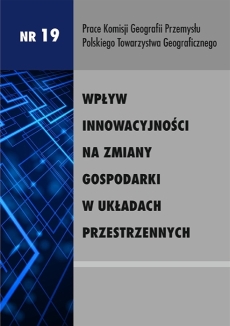Post-military areas as space for business opportunities and innovation
DOI:
https://doi.org/10.24917/20801653.19.12Słowa kluczowe:
Post-military areas, Czech RepublicAbstrakt
One of the characteristic features of the transformation processes taking place in the post-communist countries of Central Europe is the emergence of unused buildings and sites - so-called brownfields. These can be divided into several kinds, according to their original function. One of these is also the so-called military brownfield. Most of such areas were transferred, after the most necessary clean-up, to municipalities, which approached and still approach their further utilization highly individually, in connection with the character of the site as well as that of the municipality itself. Equally individual is the respective successfulness or unsuccessfulness of the revitalization of post-military areas as measured by differing indicators. The functions which revitalized former military areas have acquired are varied. One of the most common is the production function (e.g. industrial zones), residential function (housing zones), production-residential (a mix of production and housing) and production-servicing (a mix of production and services). The following contribution will first analyze demilitarization in the Czech Republic from the point of view of systemic changes in the Czech military doctrine; in the second part case studies are introduced, illustrating the transformational changes in selected settlements, caused by the loss of their military function.Downloads
Bibliografia
Fňukal M., 2011, Demografické aspekty globalizace, [in:] V. Mezřický (ed.), Perspektivy Globalizace, Portál, Praha, p. 79–109.
Illner M., 2010, Deindustrializace průmyslových měst – projevy, příčiny, důsledky a strategie revitalizace, [in:] L. Hruška-Tvrdý, Industriální město v postindustriální společnosti, VŠB-TU Ostrava, Ostrava, p. 9–20.
Integrovaný portál MPSV, 2012, Statistiky nezaměstnanosti, portal MPSV, http://portal.mpsv.cz/sz/
stat/nz/mes
Jackson J., 2003, Brownfields klasifikace a kategorizace – Brownfields ABC, Praha, 14 p.
Jarczewski W., Kuryło M., 2009, Rewitalizacja terenów powojskowych, [in:] W. Jarczewski (ed.),
Przestrzenne aspekty rewitalizacji – środmieścia, blokowiska, tereny poprzemysłowe, pokolejowe
i powojskowe, Institut Rozwoju Miast, Kraków, p. 243–289.
Keller J., 2011, Koncept postindustriální společnosti a jeho slabiny, Sociológia, Vol. 43, No 4, p. 323–337.
Kuda F., Smolová I., 2007, Technické a geografické aspekty integrace neprůmyslových brownfieldů do území, Ostrava, p. 150.
Kunc J., Klusáček P., Martinát S., 2011, Percepce a lokalizace urbánních brownfields: podobnosti a rozdíly na příkladu Brna a Ostravy, Urbanismus a územní rozvoj, Vol. XIV, No 1, p. 13–17.
Lever W.F., 2001, The Post-fordist City, [in:] R. Paddison (ed.), Handbook of Urban Studies, Sage, London, p. 273–283.
Marcuse P., van Kempen M., 2000, Globalizing Cities: A New Spatial Order?, London, p. 336.
Matlovič R., Ira V., Sýkora L., Szczyrba Z., 2001, Procesy transformacyjne struktury przestrzennej miast postkomunistycznych (na przykładzie Pragi, Bratysławy, Ołomuńca oraz Preszowa), [in:] I. Jażdzewska (ed.), Miasto postsocjalistyczne – organizacja przestrzeni miejskiej i jej przemiany(II), XIV Konwersatorium Wiedzy o Mieście, Uniwersytet Łódzki, Łódź, p. 9–21.
Město Žatec, 2007, Slavnostní otevření zóny TRIANGLE, Město Žatec, http://www.mesto-zatec.cz/videa/31-12-2007/2008-01-05.html
Ministerstvo Financí ČR, 2011, Registr ekonomických subjektů (RES), Praha.
Panasonic, 2011, O společnosti Panasonic Liquid Crystal Display Czech, s.r.o., Panasonic, http://www.panasonic.cz/html/cs_CZ/O+Panasonicu/Tov%C3%A1rny+v+%C4%8CR/PLDCZ+-
+%C5%BDatec/O+Spole%C4%8Dnosti/8087057/index.html
Pecka J., 1996, Odsun sovětských vojsk z Československa 1989–1991, Praha, p. 351.
Šilhánková V. et. al., 2006, Rekonverze vojenských brownfields, Pardubice, p. 218.
Ústecký kraj, 2012, Triangle průmyslová zóna – Investoři v zóně, Ústecký kraj, http://www.kr-ustecky.cz/vismo/dokumenty2.asp?id_org=450018&id=1660388&p1=188105
Zahradník P., Jedlička J., 2008, Studie ekonomických dopadů realizace Strategické průmyslové zóny Triangle, Ústí nad Labem, p. 59.
Žatecký deník, 2009, IPS Alpha propouštěla neslušně, zákon ale neporušila, Deník. cz., http://zatecky.denik.cz/zpravy_region/ips_alpha_propousteni_20090330.html
Pobrania
Opublikowane
Jak cytować
Numer
Dział
Licencja
Artykuły publikowane są zgodnie z warunkami licencji Creative Commons (CC BY-ND 4.0; uznanie autorstwa-bez utworów zależnych).

